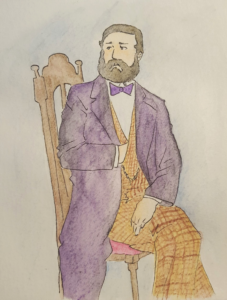Iván Szabó

Iván Szabό (1822-1858) was from Marosvásárhely, present-day Târgu Mureş, a city in Transylvania, then part of Hungary. Not much is known about Szabό’s early life other than his education in many languages. As a young adult, Szabό ran a book-selling business in Pest, nowadays a part of Budapest.
Military
In 1848, the region witnessed a major conflict between local populations and the Habsburg Empire as a part of the Hungarian revolution. Iván Szabό was heavily involved in the resistance against the empire: He was a captain in the siege of the city of Komárom, which later became a bastion of Hungarian resistance. The Austrian enemy besieged this city, but the Austrians successfully ended the war quickly by offering the generals good terms if they surrendered. From these generous terms, Szabό had enough funds to move to St Andrews in 1849.
Education
Once in St Andrews, he left his military path and utilised his knowledge of languages, landing a teaching job at Madras college. He taught French and German and assisted the Headmaster of Modern Languages, Samuel Messieux. He also taught private language courses for adults and later taught at Abbey Park school.
Photography
Since St Andrews was a dynamic and important centre of early photography, it is not surprising that Szabό also learned the art of photography. Thomas Rodger, the professional photographer in town, taught him the calotype process, an early photographic process. Szabό was active as an amateur photographer until 1857. He moved to Edinburgh in 1857 and opened his own professional studio there, perhaps to establish himself as a solo artist without his mentor.
Iván Szabό was primarily a portrait photographer. Among other honours, he was commissioned for the profile portrait of Sir Henry Fox Talbot, who had introduced the early Calotype photographic process he was using. He also photographed Sir David Brewster, the principal of United College at St Andrews University and the leading figure in the photographic circle of St Andrews. However, most of Szabό’s sitters were members of the upper classes paying for immortalisation in detail owing to the new photographic technology.
Since the creation of photographs was highly complex at the time, Szabό employed James Farmer as his assistant. Letters of correspondence between members of the photographic circle and their customers in St Andrews and beyond allow for an insight into the then time-consuming practice of taking photographs: We spent almost three hours this morning at Mr Ivan Szabo’s: he made two portraits (or rather four) of Rosamond and Tilly which he is very happy with; he would have liked to have done Matilde in another costume, a third time, but there was not enough time.
Iván Szabό’s photographic work rose considerable critical acclaim, it was even displayed at various prestigious exhibitions. His largest known entry was a series of 26 portraits at the “London Photographic Society Exhibition of Photographs and Daguerreotypes” that opened at South Kensington Museum on 15 February 1858. Critics at the annual “Photographic Society of Scotland’s exhibition” equalled him with his teacher, Thomas Rodger. In 1857, he won a Gold Medal at a Brussels exhibition.
Legacy
As he was from outside the UK, Madras college once defined him as one of the “foreign riches” brought to St Andrews by the school, thus using Szabό to promote the importance of the school.
Many photographic societies were founded around Scotland to promote the new technique and encourage experiments to refine it. In 1856, Szabό was made an honorary member of the Photographic Society of Scotland – as one of very few foreigners. His reaction was modest: He said that he would be happy to be just an ordinary member.
Even the great Sir David Brewster recommended Szabό as a photographer in a letter:
If you know of any friends who wish to have a good photograph of their family, I would recommend to them, as a first rate artist, Mr Szabo, a Hungarian who was one of the Hungarian army surrendered at Komorn [sic]. […] He is quite a gentleman and a most sensible fellow. […]
